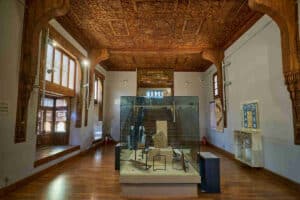Lovers of Egyptology and its museums have been waiting for many years for a date that never came: the date when the Great Egyptian Museum of Giza (GME) will finally be open. Has that moment finally arrived? At the time of writing this post, in November 2024, we can say yes, although with nuances. Here is some valuable descriptive information, which will serve as an appetizer of what is to come.
Yes, the Great Egyptian Museum at Giza is open, but…
… but not everything. In fact, some of the most important areas of the museum have yet to be opened and the official inauguration, which will be attended by high dignitaries of the country and great personalities of culture and politics from the rest of the world, has not yet taken place. In fact, this opening can be considered almost a test to see how well it is accepted by the public and to what extent it can be included in the tourist packages of agencies such as ours.
What can be visited at the GME?
Those who have the privilege of visiting the GME now, before its full opening, will be able to tour only parts of the site. However, considering that it will become one of the largest museums in the world, this ‘reduced’ tour may well extend over several hours.
Entrance, hall and staircase
Just getting to the Great Egyptian Museum of Giza is an impressive experience: contemplating its main façade is impressive for its monumentality and forms, which are inspired by the famous pyramids of Giza, located a couple of kilometers from here. The design, mainly by Heneghan Peng Architects, has tried to emphasize the amplitude of spaces, the play of light, its dialogue with the environment and a museum proposal that includes the latest technological innovations for the visit.
After entering through the main entrance, the hall leaves the visitor speechless, not only for the architecture but especially for the welcome of its great protagonist: a colossal statue of Ramses II that seems to emerge from a sheet of water, perhaps as a reference to the Nile or the primordial waters that, according to the Egyptian religion, were the origin of life.
From the hall, the visitor goes to the open rooms and, to reach them, has to climb a staircase that hides another surprise: the contemplation, through a large window, of the Pyramids of Giza: a vision that reminds the visitor that everything is real and that civilization is presented before his eyes.
The 12 visitable rooms
After the staircase, we reach the beginning of the tour itself, which for now has been conceived as a summary and first contact with the rich collection that will house the museum. These 12 rooms make a historical and chronological tour of Ancient Egypt, but the content is also grouped by theme, in order to facilitate the understanding of the collection to the visitor:
- Rooms 1, 2 and 3: Pre-Pharaonic civilization and early dynasties (Ancient Empire)
- Rooms 4, 5 and 6: Middle Empire
- Rooms 7, 8 and 9: New Empire
- Rooms 10, 11 and 12: Ptolemaic and Roman Egypt
In all the rooms are exhibited pieces, documents and statues of enormous value, highlighting those of the kings Chephren and Mycerinus (Room 2), Sesostris I (Room 4), Hatshepsut (Room 8) or Alexander the Great.
And what remains to be opened and exhibited?
After this review of what has already been exhibited at the GME, it is time to ask: what’s left? And it is a lot, because they are its ‘highlights’, no doubt. Specifically, the entire tomb of Tutankhamun, which will be exhibited in great detail. And in addition, the solar boat of Cheops, discovered decades ago in the Great Pyramid of Giza and that will find here a large and adequate space for its exhibition. But that will be in 2025… if the forecasts are fulfilled.




